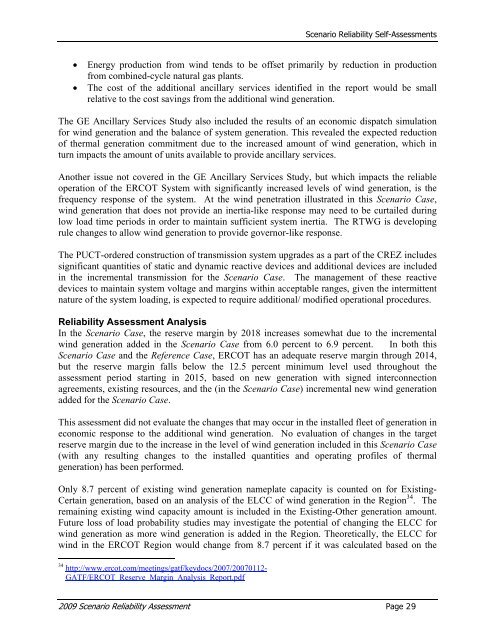2009 Scenario Reliability Assessment - NERC
2009 Scenario Reliability Assessment - NERC
2009 Scenario Reliability Assessment - NERC
- No tags were found...
You also want an ePaper? Increase the reach of your titles
YUMPU automatically turns print PDFs into web optimized ePapers that Google loves.
<strong>Scenario</strong> <strong>Reliability</strong> Self-<strong>Assessment</strong>sEnergy production from wind tends to be offset primarily by reduction in productionfrom combined-cycle natural gas plants.The cost of the additional ancillary services identified in the report would be smallrelative to the cost savings from the additional wind generation.The GE Ancillary Services Study also included the results of an economic dispatch simulationfor wind generation and the balance of system generation. This revealed the expected reductionof thermal generation commitment due to the increased amount of wind generation, which inturn impacts the amount of units available to provide ancillary services.Another issue not covered in the GE Ancillary Services Study, but which impacts the reliableoperation of the ERCOT System with significantly increased levels of wind generation, is thefrequency response of the system. At the wind penetration illustrated in this <strong>Scenario</strong> Case,wind generation that does not provide an inertia-like response may need to be curtailed duringlow load time periods in order to maintain sufficient system inertia. The RTWG is developingrule changes to allow wind generation to provide governor-like response.The PUCT-ordered construction of transmission system upgrades as a part of the CREZ includessignificant quantities of static and dynamic reactive devices and additional devices are includedin the incremental transmission for the <strong>Scenario</strong> Case. The management of these reactivedevices to maintain system voltage and margins within acceptable ranges, given the intermittentnature of the system loading, is expected to require additional/ modified operational procedures.<strong>Reliability</strong> <strong>Assessment</strong> AnalysisIn the <strong>Scenario</strong> Case, the reserve margin by 2018 increases somewhat due to the incrementalwind generation added in the <strong>Scenario</strong> Case from 6.0 percent to 6.9 percent. In both this<strong>Scenario</strong> Case and the Reference Case, ERCOT has an adequate reserve margin through 2014,but the reserve margin falls below the 12.5 percent minimum level used throughout theassessment period starting in 2015, based on new generation with signed interconnectionagreements, existing resources, and the (in the <strong>Scenario</strong> Case) incremental new wind generationadded for the <strong>Scenario</strong> Case.This assessment did not evaluate the changes that may occur in the installed fleet of generation ineconomic response to the additional wind generation. No evaluation of changes in the targetreserve margin due to the increase in the level of wind generation included in this <strong>Scenario</strong> Case(with any resulting changes to the installed quantities and operating profiles of thermalgeneration) has been performed.Only 8.7 percent of existing wind generation nameplate capacity is counted on for Existing-Certain generation, based on an analysis of the ELCC of wind generation in the Region 34 . Theremaining existing wind capacity amount is included in the Existing-Other generation amount.Future loss of load probability studies may investigate the potential of changing the ELCC forwind generation as more wind generation is added in the Region. Theoretically, the ELCC forwind in the ERCOT Region would change from 8.7 percent if it was calculated based on the34 http://www.ercot.com/meetings/gatf/keydocs/2007/20070112-GATF/ERCOT_Reserve_Margin_Analysis_Report.pdf<strong>2009</strong> <strong>Scenario</strong> <strong>Reliability</strong> <strong>Assessment</strong> Page 29
















